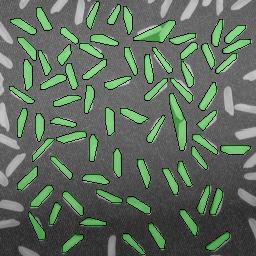Image visualization using transparency
Transparent graphics objects can be used effectively to visualize image processing concepts. Two particularly useful techniques are:
- Highlighting image regions with transparent patches
- Displaying one image transparently over another
Today I'll show how to highlight image regions with patches. For this example I'll use the 'Extrema' measurement returned by regionprops. The extrema for a given object are eight points: the left-most pixel on the bottom, the right-most pixel on the bottom, the top-most pixel on the right, the bottom-most pixel on the right, and so on.
I'll start with the rice image, segmenting it using techniques I've shown before.
I = imread('rice.png');
imshow(I)
Even out the illumination with the tophat operator, threshold, and then clean up the thresholded image a bit.
I2 = imtophat(I, ones(15, 15)); bw = im2bw(I2, graythresh(I2)); bw2 = bwareaopen(bw, 5); bw3 = imclearborder(bw2); imshow(bw3)

Label the binary objects and compute the extrema.
L = bwlabel(bw3);
s = regionprops(L, 'Extrema');Each object has 8 extrema points associated with it.
s(1).Extrema
ans =
11.5000 86.5000
12.5000 86.5000
34.5000 100.5000
34.5000 102.5000
33.5000 103.5000
27.5000 103.5000
9.5000 89.5000
9.5000 87.5000
We can superimpose the extrema-bounded shapes on top of the original rice image by using patch objects.
imshow(I) hold on for k = 1:numel(s) x = s(k).Extrema(:,1); y = s(k).Extrema(:,2); patch(x, y, 'g') end hold off

The above visualization is pretty clear. If you zoom in on some of the odd, larger shapes, though, you can't really tell what's going on.
axis([120 200 1 75])

We solve that by displaying the patches transparently.
imshow(I) hold on for k = 1:numel(s) x = s(k).Extrema(:,1); y = s(k).Extrema(:,2); patch(x, y, 'g', 'FaceAlpha', 0.3) end hold off

Now if you zoom in on the same region, we can see exactly what caused the unusual region.
axis([120 200 1 75])

Two of the rice grains were touching.
Next time I'll show a couple of techniques for visualizing one image transparently superimposed on another.









コメント
コメントを残すには、ここ をクリックして MathWorks アカウントにサインインするか新しい MathWorks アカウントを作成します。